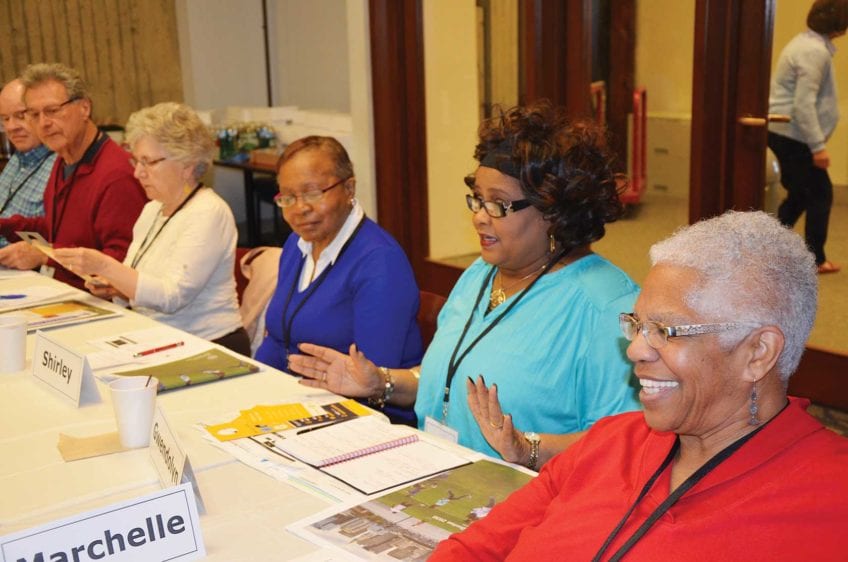

Kerry Ann Mendes, M.S., R.D.
Dietitian, Whittier Street Health Center
“General nutritional concepts remain the same across the age span,” said Kerry Ann Mendes, the dietitian at Whittier Street Health Center. Everyone, regardless of age is recommended to eat fruits and vegetables, whole grains, low-fat proteins and healthy fats.
However, other changes that come with age may influence appetite and impair good nutrition. “There are sensory changes,” explained Dr. Monera Wong, associate chief of Geriatric Medicine at Massachusetts General Hospital. A reduction in the sensitivity of the taste buds can make food taste bland. Diminished sense of smell and vision add to the problem. “Our enjoyment of eating is greatly influenced by how foods smell and look,” she explained.
With a loss of appetite, a picture begins to evolve of the challenge to ensure good nutrition in the elderly. For those who lose their appetite, Mendes recommends eating more frequent small meals — five mini meals will do — and healthy snacks, such as fruits and nuts throughout the day.
In addition, some nutrients are harder for older people to consume and absorb. Vitamin D is one such example. Vitamin D helps the body absorb calcium, maintain bone density, or strength, and reduce the risk of osteoporosis. Research is ongoing to determine the vitamin’s impact on several chronic diseases, such as diabetes and heart disease, both common among the elderly.
Formation of vitamin D is a complex process that requires cooperation among the sun, skin, liver and kidney. However, darker skin does not readily absorb the sun’s rays. Also, in the North the sun is not strong enough for a large part of the year to set the process in motion. In addition, there’s evidence that older people are less efficient vitamin D producers than younger people. A further complication is that few foods are a natural source of vitamin D. Examples are salmon and other fatty fish and fortified juices and cereals.
Vitamin D’s cohort for maintaining strong bones is calcium, a major source of which is dairy products. “Lactose intolerance increases with age,” explained Mendes. “You have to find alternatives, such as calcium-fortified cereals and orange juice and leafy greens.”
The Institute of Medicine recommends 1,200 milligrams of calcium a day and 600 to 800 IU of vitamin D a day for seniors.
Vitamin B12 is another vitamin that is harder to absorb with age. Vitamin B12 helps create red blood cells and DNA and maintains healthy nerve function. However, many older people experience a thinning of the stomach lining or other digestive disorders that hamper the absorption of the vitamin. Sometimes even eating foods high in vitamin B12, such as fish, meat and milk is not enough. A supplement may be required.
It’s not only what people eat. What one drinks is equally important. “Two liters (estimated 2 quarts) a day is the recommended minimum, Mendes explained, but some people never approach that amount — and often on purpose. Some seniors decrease their water intake, particularly if they’re on medication that increases urination. They drink less so they don’t have to be tied to the bathroom.
An additional problem is the apparent slow-down of the metabolism in some seniors. Some experts, however, contend that one’s metabolism remains fairly stable throughout life. What actually occurs is a decrease in muscle mass accompanied by an increase in the amount of fat, which results in a lower resting metabolism. In turn the body burns fewer calories.
A lower resting metabolism has to be countered by decreased consumption of calories and increased regular exercise to maintain a healthy weight. That does not always happen. “Older people are more sedentary and have conditions like arthritis that slows people down,” said Mendes.
Almost 40 percent of adults 60 and over are obese, according to the latest figures from the Centers for Disease Control and Prevention. Excess weight in the elderly is linked to an increased risk of a myriad of health conditions, including high blood pressure and cholesterol, diabetes, osteoarthritis and even cancer,.
Advice to the elders is often a family affair, but that’s not always a good thing, she explained. Some family members say “Grandpa needs to get healthy” while others have the attitude “Grandpa is old and can eat anything he wants.”
Mendes is clear on one point. There is variability among the status of elders. It’s the lifestyle changes that often dictate how healthy an older person remains. “Those who are still active and have a healthy weight have fewer problems,” she explained.







